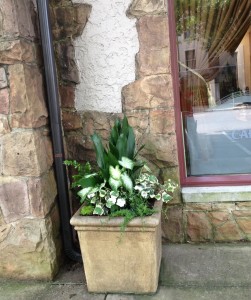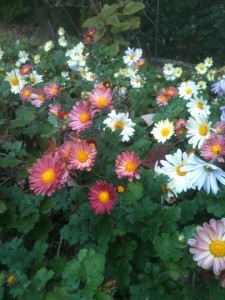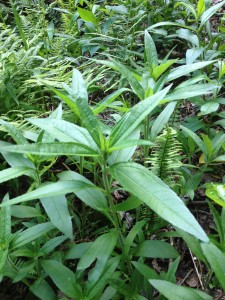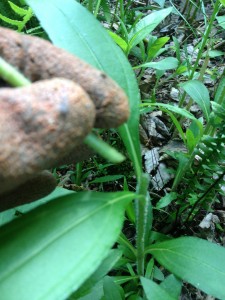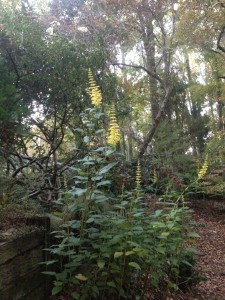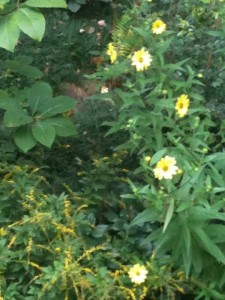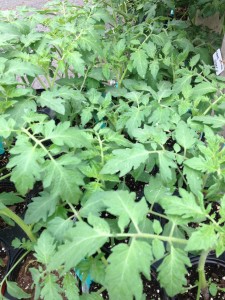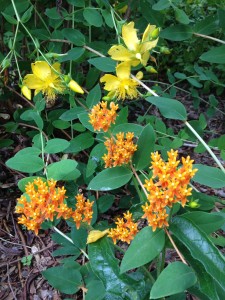 Butterfly weed, Asclepias tuberosa, is the pretty orange flower, shown in the picture on the right in my very hot and sunny front border. It’s right at home with other butterfly attractors including salvias, trailing white lantana, purple and red gomphrena, zinnias, mexican heather, other heat loving annuals and, shown in the picture with the butterfly weed, a yellow hypericum shrub. It also is happy with other perennials. To be successful in atracting butterflies, you need to have sources of nectar, sources for them to lay their eggs on, and plants for the caterpillars to feed on…monarch butterflies like to lay their eggs on this asclepias, so it’s a very good butterfly plant to have!
Butterfly weed, Asclepias tuberosa, is the pretty orange flower, shown in the picture on the right in my very hot and sunny front border. It’s right at home with other butterfly attractors including salvias, trailing white lantana, purple and red gomphrena, zinnias, mexican heather, other heat loving annuals and, shown in the picture with the butterfly weed, a yellow hypericum shrub. It also is happy with other perennials. To be successful in atracting butterflies, you need to have sources of nectar, sources for them to lay their eggs on, and plants for the caterpillars to feed on…monarch butterflies like to lay their eggs on this asclepias, so it’s a very good butterfly plant to have!
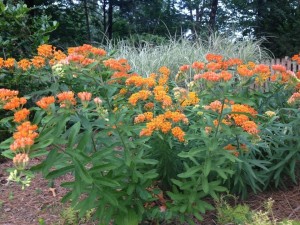
Butterfly weed in my friend Carole Barton’s garden…
It’s the flowering star right now in my garden and in my friend and wholesale grower Carole Barton’s garden also. Her very impressive stand of it in the picture to the left must be heaven for butterflies! Even for those folks opposed to orange flowers, I hope you will try to find a spot for this one anyway…in addition to attracting butterflies it also is a magnet for other beneficial insects including lady beetles and bees.
Since it has a long tap root, take care in transplanting this perennial butterfly weed. It can be difficult to find, but we have these plants available now, if there’s a sunny spot in your garden and you’d like to try it for yourself. The long tap root also makes it tolerant of drought once established – a huge plus in my book! It will benefit from deadheading (cutting off the old blooms) after it’s through flowering – if you don’t get this done it may reseed, which might not be a bad thing depending on where you want it! It also reappears quite late in the spring – I worry each and every year that I’ve lost it and then, happy surprise, it reappears…
– Posted using BlogPress from my iPhone

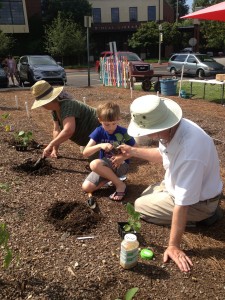
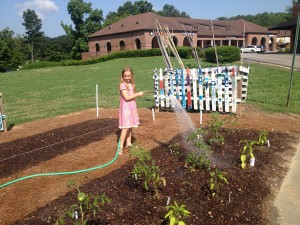
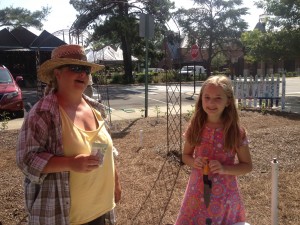 The garden is a teaching garden, and this year our market manager, Dená Hand, is lending her teaching abilities and helping Billy. This is a fun learning experience for kids who sign up with the “Dig Into Reading” program. Feel free to come by even if you’re not signed up though!
The garden is a teaching garden, and this year our market manager, Dená Hand, is lending her teaching abilities and helping Billy. This is a fun learning experience for kids who sign up with the “Dig Into Reading” program. Feel free to come by even if you’re not signed up though!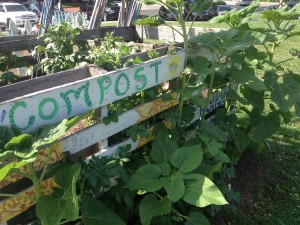 It’s a display garden as well, and folks are encouraged to come by, see how things are growing and ask questions throughout the summer. Do you have an elderly neighbor or friend that would appreciate any of the vegetables that are grown? Feel free to harvest and share with the community!
It’s a display garden as well, and folks are encouraged to come by, see how things are growing and ask questions throughout the summer. Do you have an elderly neighbor or friend that would appreciate any of the vegetables that are grown? Feel free to harvest and share with the community! Owners Frank and Pardis Stitt prefer white and green for the front of this French cafe, located next to their acclaimed restaurant Highlands in downtown Birmingham. These are fairly large, tan colored cast stone planters with nice clean lines. A mix of contrasting green and variegated foliage with a touch of white add light to this shady spot, and the stone wall adds a pleasing backdrop to the planting.
Owners Frank and Pardis Stitt prefer white and green for the front of this French cafe, located next to their acclaimed restaurant Highlands in downtown Birmingham. These are fairly large, tan colored cast stone planters with nice clean lines. A mix of contrasting green and variegated foliage with a touch of white add light to this shady spot, and the stone wall adds a pleasing backdrop to the planting.